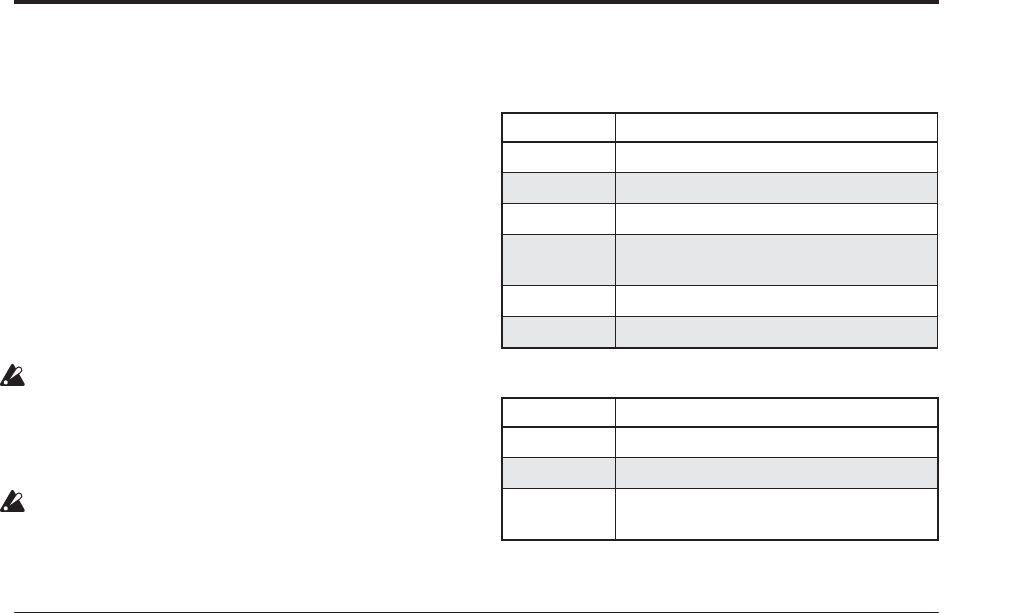
Basic Information About polyphony
33
The Expansion Sample Setup has now been
changed. In order for your changes to take effect,
please turn the power off, and then on again.
[OK]
-------------
This completes the Expansion Sample Setup
operation. The next time you turn on the power, the
specified PCM bank will be loaded and available.
6. Press the OK button.
7. Turn off the power.
The next time you turn on the power, the specified
PCM bank will be loaded and available.
When you turn off the power, any data you had
been editing will be lost. You must save your data
before you turn off the power.
8. Wait about ten seconds, and then turn the power
on again.
After turning the power off, you must wait ten
seconds before you turn the power on again.
9. Select and play programs and combinations that
use the loaded multisamples/samples.
For details, please refer to the tables below.
Program banks and PCM memory
Combination banks and PCM memory
About polyphony
Most hardware synthesizers offer a single, fixed
method of synthesis, a predetermined number of
voices, and a fixed amount of effects processing power.
OASYS is different; it has no fixed synthesis method,
and it shares its processing power between voices and
effects.
This flexibility means that the system can deliver
power where you need it the most. For instance, one
Program may need a bunch of voices layered together,
but not many effects; another might need complex
effects processing, but not as many voices. In both
cases, OASYS will automatically divide its processing
power appropriately.
Unlike most computer-based systems, OASYS also
monitors the overall processing power, reducing the
overall number of voices if necessary, to make sure that
there are never problems with the audio.
Normally, you shouldn’t need to think about this at all;
it will just happen automatically. Sometimes, however,
it can be convenient to know how the system is
allocating its resources. The Effect/EXi Resource
Meter, shown on the P8: Insert Effect– Insert FX, Track
View and P9: Master Effect– Routing pages of each
mode, provides this information.
Effect/EXi Fixed Resource Meter
The resource meter shows how the OASYS processing
power is being used, as an approximate percentage of
the total available power. There are three main
categories: FX, EXi Fixed, and Free for Voices.
Note: the displayed values are rounded to the closest
1%, but the internal values have a much finer
resolution. This means that you may sometimes add an
effect, but see no change in the resource meter.
FX
This shows the percentage of the total processing
power being used for the IFX, MFX, and TFX. This will
vary depending on the specific effects being used.
If an effect has been assigned to an IFX, MFX, or TFX, it
will take up the same amount of processing resources
even if it is turned Off or bypassed. If you want to free
up the processing resources, change the selection to
000: No Effect.
EXi FIXED
This shows the percentage of the total processing
power used for the fixed components of EXi
instruments. “Fixed” means that part of the EXi starts
using processing power as soon as the EXi is loaded,
before playing any notes; this includes the built-in
effects of the CX-3, for example.
Only some EXi include fixed components; for instance,
the CX-3 does, but the AL-1 does not. For information
on other EXi, see their individual documentation.
For more information on EXi fixed resources, please
see “CX-3 & STR-1: Limitations on EXi fixed resources”
on page 326.
FREE FOR VOICES
This shows the percentage of the total processing
power remaining after the FX and EXi fixed
components. This power is available for playing
synthesizer voices.
When Free for Voices is at 100%, you can achieve the
maximum polyphony–for instance, 172 voices of the
HD-1, 96 voices of the AL-1, or 172 voices of the CX-3.
When more effects or EXi fixed resources are being
used, polyphony will be reduced accordingly.
Bank Expansion Samples Required?
INT-A…D No
INT-E Requires EXs1
INT-F, USER-F No
GM, g(1)
…g(9), g(d)
No
USER-A Requires EXs2
USER-B…E, G No
Bank Expansion Samples Required?
INT-A, B No
INT-C Requires EXs1
INT-D…G
USER-A…G
No


















